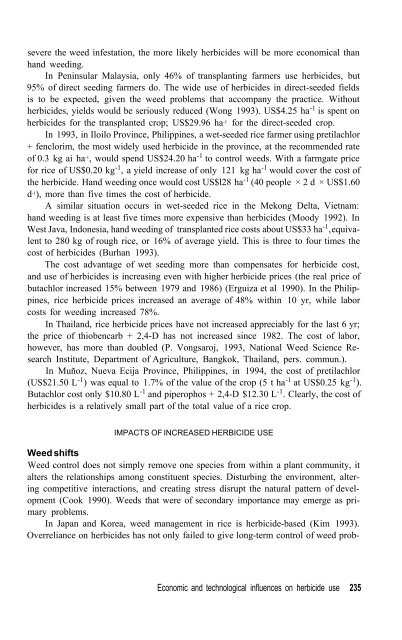HERBICIDES in Asian rice - IRRI books - International Rice ...
HERBICIDES in Asian rice - IRRI books - International Rice ...
HERBICIDES in Asian rice - IRRI books - International Rice ...
You also want an ePaper? Increase the reach of your titles
YUMPU automatically turns print PDFs into web optimized ePapers that Google loves.
severe the weed <strong>in</strong>festation, the more likely herbicides will be more economical than<br />
hand weed<strong>in</strong>g.<br />
In Pen<strong>in</strong>sular Malaysia, only 46% of transplant<strong>in</strong>g farmers use herbicides, but<br />
95% of direct seed<strong>in</strong>g farmers do. The wide use of herbicides <strong>in</strong> direct-seeded fields<br />
is to be expected, given the weed problems that accompany the practice. Without<br />
herbicides, yields would be seriously reduced (Wong 1993). US$4.25 ha -1 is spent on<br />
herbicides for the transplanted crop; US$29.96 ha -1 for the direct-seeded crop.<br />
In 1993, <strong>in</strong> Iloilo Prov<strong>in</strong>ce, Philipp<strong>in</strong>es, a wet-seeded <strong>rice</strong> farmer us<strong>in</strong>g pretilachlor<br />
+ fenclorim, the most widely used herbicide <strong>in</strong> the prov<strong>in</strong>ce, at the recommended rate<br />
of 0.3 kg ai ha -1 , would spend US$24.20 ha -1 to control weeds. With a farmgate p<strong>rice</strong><br />
for <strong>rice</strong> of US$0.20 kg -1 , a yield <strong>in</strong>crease of only 121 kg ha -1 would cover the cost of<br />
the herbicide. Hand weed<strong>in</strong>g once would cost US$l28 ha -1 (40 people × 2 d × US$1.60<br />
d -1 ), more than five times the cost of herbicide.<br />
A similar situation occurs <strong>in</strong> wet-seeded <strong>rice</strong> <strong>in</strong> the Mekong Delta, Vietnam:<br />
hand weed<strong>in</strong>g is at least five times more expensive than herbicides (Moody 1992). In<br />
West Java, Indonesia, hand weed<strong>in</strong>g of transplanted <strong>rice</strong> costs about US$33 ha -1 , equivalent<br />
to 280 kg of rough <strong>rice</strong>, or 16% of average yield. This is three to four times the<br />
cost of herbicides (Burhan 1993).<br />
The cost advantage of wet seed<strong>in</strong>g more than compensates for herbicide cost,<br />
and use of herbicides is <strong>in</strong>creas<strong>in</strong>g even with higher herbicide p<strong>rice</strong>s (the real p<strong>rice</strong> of<br />
butachlor <strong>in</strong>creased 15% between 1979 and 1986) (Erguiza et al 1990). In the Philipp<strong>in</strong>es,<br />
<strong>rice</strong> herbicide p<strong>rice</strong>s <strong>in</strong>creased an average of 48% with<strong>in</strong> 10 yr, while labor<br />
costs for weed<strong>in</strong>g <strong>in</strong>creased 78%.<br />
In Thailand, <strong>rice</strong> herbicide p<strong>rice</strong>s have not <strong>in</strong>creased appreciably for the last 6 yr;<br />
the p<strong>rice</strong> of thiobencarb + 2,4-D has not <strong>in</strong>creased s<strong>in</strong>ce 1982. The cost of labor,<br />
however, has more than doubled (P. Vongsaroj, 1993, National Weed Science Research<br />
Institute, Department of Agriculture, Bangkok, Thailand, pers. commun.).<br />
In Muñoz, Nueva Ecija Prov<strong>in</strong>ce, Philipp<strong>in</strong>es, <strong>in</strong> 1994, the cost of pretilachlor<br />
(US$21.50 L -1 ) was equal to 1.7% of the value of the crop (5 t ha -1 at US$0.25 kg -1 ).<br />
Butachlor cost only $10.80 L -1 and piperophos + 2,4-D $12.30 L -1 . Clearly, the cost of<br />
herbicides is a relatively small part of the total value of a <strong>rice</strong> crop.<br />
IMPACTS OF INCREASED HERBICIDE USE<br />
Weed shifts<br />
Weed control does not simply remove one species from with<strong>in</strong> a plant community, it<br />
alters the relationships among constituent species. Disturb<strong>in</strong>g the environment, alter<strong>in</strong>g<br />
competitive <strong>in</strong>teractions, and creat<strong>in</strong>g stress disrupt the natural pattern of development<br />
(Cook 1990). Weeds that were of secondary importance may emerge as primary<br />
problems.<br />
In Japan and Korea, weed management <strong>in</strong> <strong>rice</strong> is herbicide-based (Kim 1993).<br />
Overreliance on herbicides has not only failed to give long-term control of weed prob-<br />
Economic and technological <strong>in</strong>fluences on herbicide use 235

















